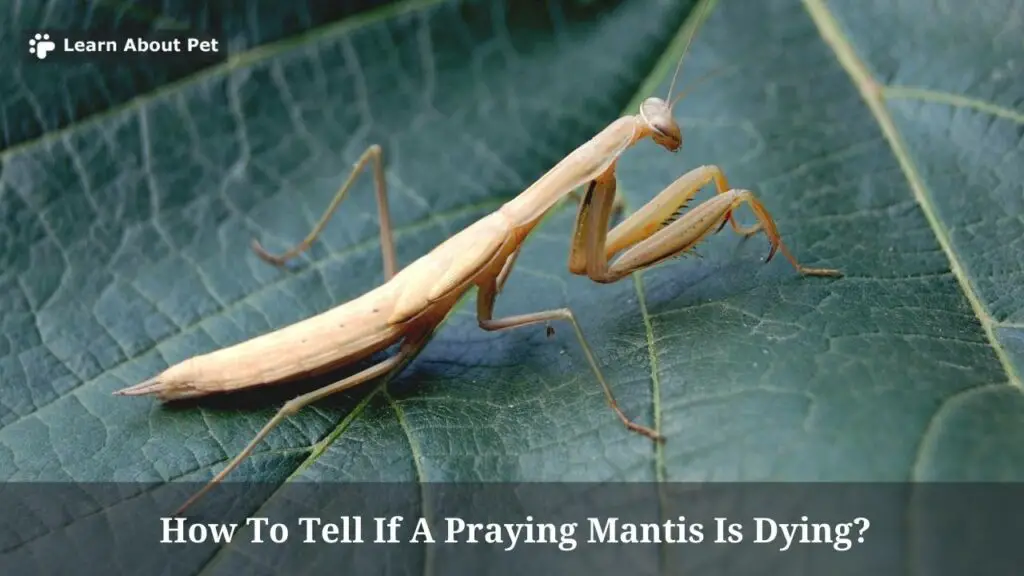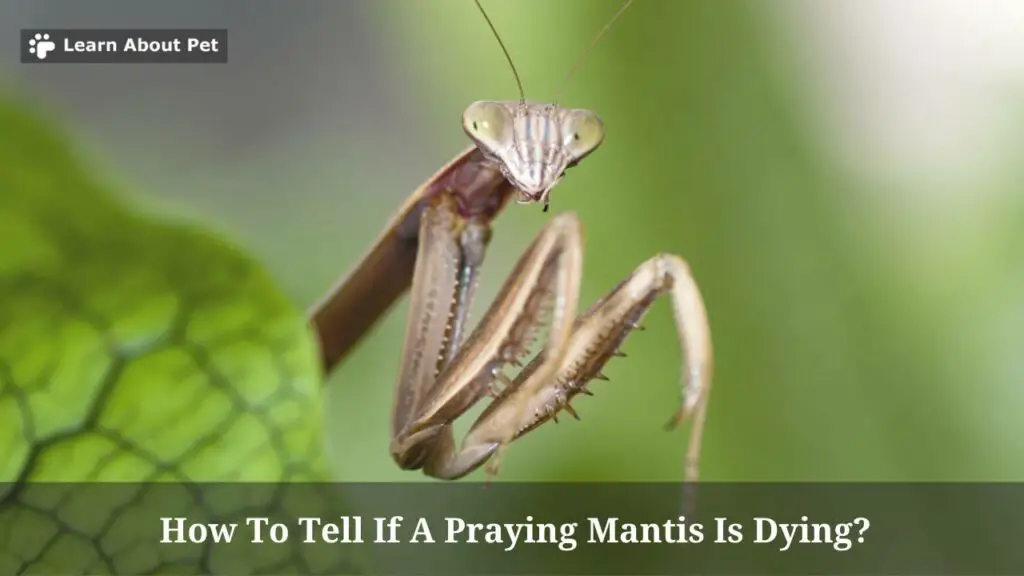One of the questions that people who keep praying mantises as pets tend to pose is on how to tell if a praying mantis is dying. In this article, you will find comprehensive information on the signs through which you can know that a praying mantis is dying.
If one is able to tell when a praying mantis is dying, it may be possible to put in place timely mitigating measures, to prevent the insect’s death.
But if one is unable to pick up the praying mantis dying signs, they won’t be able to try to help the insect. The end result is likely to be a situation in which one just comes to find the praying mantis dead.
Simply coming to find the praying mantis dead in that way can be cause for major regrets. One is bound to have regrets about having let the praying mantis die.

The only way to avoid such regrets is by having some understanding of praying mantis dying symptoms. Upon noting those symptoms, you would know that your praying mantis is probably dying.
Then you would put in place the necessary mitigating measures, to possibly save the praying mantis’ life.
In a nutshell, this is how to tell if a praying mantis is dying: by observing its appetite, mobility and color. A dying praying mantis will typically have very little or no appetite.
It will also be largely immobile: making almost no body movements. And its color will tend to change, with brown spots usually appearing on its body.
How Do Praying Mantis Die?
In some instances, praying mantises die suddenly. So you find a praying mantis alive (and seemingly alright) today. Then you find the praying mantis dead tomorrow.
In some other instances, praying mantises die slowly. So you find the praying mantis health and wellbeing declining slowly over time, until it dies.
The praying mantises sometimes die due to factors like dehydration, starvation, disease and injury. Poor living conditions (especially improper temperature and humidity levels) can also kill praying mantises.
Now with the regard to the sudden praying mantis deaths, those are (obviously) normally hard to foretell.
But for the slower ‘gradual’ praying mantis deaths, there may be telltale signs. And that is the basis for people asking questions like, how do you know if a praying mantis is dying? Or, more precisely, how do you know when your praying mantis is dying?
People suppose that if a praying mantis is approaching death, there must be some telltale signs.
Based on that supposition, you then find them asking, how can you tell if a praying mantis is dying?
So focus here is mainly on understanding the signs of likely impending death in praying mantis.
How To Tell If A Praying Mantis Is Dying?
There are three key things that tell you if a praying mantis is dying.
The first key thing which may tell you that a praying mantis is dying is utter loss of appetite. Most praying mantises pretty much give up eating on the day(s) preceding their death.
Not every case of loss of appetite is a sign of impending praying mantis death though. There are other factors that can make a praying mantis lose appetite.
Sometimes though, the loss of appetite occurs alongside the other signs we are going to look at. In such cases, it can be a sign of impending praying mantis death.
The second key thing which may tell you that a praying mantis is dying is reduced movement. Most praying mantises become pretty much immobile on the day(s) preceding their death.
So you just find the praying mantis not moving, but just lying around.
The third key thing which may tell you that a praying mantis is dying is change of color. Normally, when praying mantises are dying, their bodily colors change.
The commonest color change in that regard is one in which some brown spots appear on the mantis’ body.
Indeed, if you research on why do praying mantis turn brown, you will see that it can be a sign of impending death (among other things).
Normally, it is a case of the praying mantis turning brown in some parts and not others. Therefore the end result is one of the mantis appearing as if it has brown spots on its body.
One may ask, why do praying mantis turn brown when they die? And this may be attributable to the slowdown and eventual halt of bodily processes that is associated with praying mantis death.
How To Tell If A Praying Mantis Is Dying And Not Molting?
The signs through which one can tell that a praying mantis is dying are somewhat similar to those of molting.
For one, molting praying mantises lose appetite. Secondly, they also tend to become more or less immobile, lying upside down.
So the signs of possible impending death and those of molting in praying mantis are somehow similar.
This leads to interesting questions like, how do I know if my mantis is dying or molting? Or, to put it another way, is my mantis dead or molting?
Now it is true that the praying mantis dying signs and praying mantis molting signs are somewhat similar. However, there are some subtle differences.
The loss of appetite that a molting praying mantis tends to experience is usually short-lived. It is usually just for the day preceding the molt, and the day after the molt.
But the loss of appetite that a dying praying mantis experiences is usually longer-lived.
Further, the immobility experienced by molting praying mantis can be quite different from that experienced by dying ones.
In the molting situation, it is usually a case in which you find the praying mantis laying on its back. The mantis is thus upside down.
But for a sick praying mantis or a dying one, there may not be that upside posture. The mantis may remain on its feet, but motionless for very long periods of time.
(But there are also cases in which dying praying mantis lie upside down).
In this context, it may also help to learn how to tell the age of a praying mantis. Then you can consider the age, to figure out whether – given the same –the praying mantis is really likely to be molting.
How To Tell If A Praying Mantis Is Already Dead?
So far, we have been focusing on how to tell if a praying mantis is dying. But there are scenarios in which one wants to know whether the mantis is already dead.
Normally, a dead praying mantis will tend to assume a curled up posture. In fact, when a praying mantis dies, it tends to start shriveling soon thereafter.
A dead mantis may also be upside down, with its legs tending to hang (lifelessly) in the air.
Sometimes, when a praying mantis dies, a weird organism comes out of it! This often gets people wondering, what comes out of a praying mantis when it dies?
And as it turns out, what comes out of a praying mantis when it dies is usually a worm. That is specifically a horsehair worm. Its name is Chordodes formosanus.
It lives in the mantis. But when the mantis dies, it detects – and finds its way out.
Ultimately, curling up, shriveling and lying upside down with legs hanging lifelessly are the signs that a mantis is dead.

When Do Praying Mantis Die?
Sometimes, praying mantises die when their lifespans expire.
For some praying mantises, the lifespans are short – as short as 4-8 weeks. But for some other praying mantises, the lifespans are longer: as long as 8 months.
Thus the question on how do I know when my mantis will die is almost impossible to answer. It depends on the mantis’ state of health, as well as its species, its current age… and so on.
You also need to know that old age (end of expected lifespan) is not the only thing that can kill a mantis. Sometimes, praying mantis die well before the end of their expected lifespans.
That leads to a question: in what ways can praying mantises die before the expiry of their expected lifespans? And those would include things like sickness, dehydration, starvation and injury.
Thus in working out when your praying mantis is likely to die, you should also focus on such factors. Ask yourself, is my praying mantis continually well-fed and well-hydrated? Is my praying mantis sick or healthy?
In the context of the latter question, you can go further and ask, is my mantis sick or dying from factors like poor temperatures and humidity?
Also remember that there is the possibility of the mantises dying from injuries. For instance, praying mantis injury abdomen or thorax injury can often cause premature death.
Thus if you have a badly injured praying mantis, it may be dying. Especially if my praying mantis is weak following a major injury, I would regard this as a major possibility.
How Do I Know When My Praying Mantis Will Die?
The only way to guess when your praying mantis may die is by understanding its species. Then establish how long that mantis species normally lives. Thereafter, establish your praying mantis’ age.
So you look at your praying mantis’ current age. Then you look at it vis a vis the praying mantis’ species’ expected lifespan. This may give you an inkling on when you may find the said praying mantis dead.
However, you need to know that the normal expected lifespan notwithstanding, sudden death is also a possibility. So you may find a praying mantis dead suddenly – in spite of it being relatively young and seemingly healthy.
Is It Possible To Help A Dying Praying Mantis?
In some cases, it may be possible to help a praying mantis that is dying.
There are certainly cases in which people with seemingly dying praying mantises have managed to rescue them through mitigation measures.
You first need to be able to tell if a praying mantis is dying in good time. Then you may take steps to help the praying mantis.
How Do You Help A Dying Praying Mantis?
If the mantis is dying due to dehydration, you may help it through urgent rehydration.
In case the mantis is dying due to starvation, proper urgent nutrition may help.
And if the praying mantis is dying due to illness, a good exotic pets vet may offer diagnosis and treatment.
Sometimes, you may help a dying praying mantis by giving it ideal humidity and temperature conditions. These are helpful if the mantis is dying due to poor temperature and humidity.
Final Verdict – How To Tell If A Praying Mantis Is Dying
Praying mantises that are dying normally exhibit appetite, mobility and color changes.
With regard to appetite, praying mantises that are dying tend to lose it greatly or entirely.
Turning to mobility, praying mantises that are dying tend to become very immobile. They pretty much stop making movements, and just lie motionless.
And with regard to color changes, dying praying mantises tend to develop brown spots on their bodies.
Notably, praying mantises are capable of playing dead. Thus, it is important to work out whether your praying mantis is playing dead or actually dying.

For instance, while a mantis that is playing dead will lie motionless, it nonetheless suddenly becomes alert and springs to action when strongly poked.
Molting praying mantises can also appear as if they are dying. You therefore need to know the subtle differences between praying mantis dying and praying mantis molting signs.
Ultimately, if you establish that your praying mantis is dying, you may take measures to try to help it. That is unless the mantis seems to be dying of old age – in which case there isn’t much to do.
As a pet lover, make sure to learn about pet more and give your pet mantis a good and comfortable life!

Welcome to Learn About Pet. My name is Rajkumar Ravichandran and I love all pets, travel, and amazing food. I write about my passion and personal experience caring for multiple pets in this blog! ❤️
Post Disclaimer
DISCLAIMER: THIS BLOG OR WEBSITE, "Learn About Pet", DOES NOT PROVIDE YOU WITH MEDICAL ADVICE AND IS NOT A SUBSTITUTE FOR MEDICAL ADVICE. ALWAYS GET IN TOUCH WITH YOUR PERSONAL VETERINARIAN AND USE INFORMATION HERE AS GENERAL ADVICE.
The information, including but not limited to, text, graphics, images and other material contained on this website are for informational purposes only. No material on this site is intended to be a substitute for professional veterinary advice, food recommendation, diagnosis, or treatment. Always seek the advice of your veterinarian or other qualified health care provider with any questions you may have regarding a medical condition or for pet food related questions.







